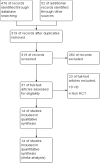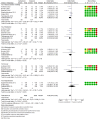Carbetocin versus oxytocin in prevention of postpartum hemorrhage after cesarean delivery in high-risk women. A systematic review and meta-analysis
- PMID: 40240535
- PMCID: PMC12334512
- DOI: 10.1007/s00404-025-08014-6
Carbetocin versus oxytocin in prevention of postpartum hemorrhage after cesarean delivery in high-risk women. A systematic review and meta-analysis
Abstract
Objectives: To assess the value of carbetocin in prevention of postpartum hemorrhage (PPH) after Cesarean delivery (CD).
Search strategy: Screening of PubMed, Web Of Science, Scopus, register clinical trials registry and Google scholar from inception to December 2023. The keywords used included postpartum hemorrhage, intraoperative blood loss, postoperative blood loss, Cesarean delivery and their MeSH terms.
Selection criteria: All RCTs that compared carbetocin to oxytocin in women undergoing CD with risk factor for PPH. Fourteen studies including 3068 participants. Thirteen were written in English and one in Polish.
Data collection and analysis: The extracted data included location of the trial, number of centers involved in recruitment, the number of participants and their characteristics, details of the study groups and dose time and route of intervention and its comparator, primary and secondary outcome parameters and trial registration number and timing in relation to patients recruitment. The evaluated outcomes parameters included intraoperative and 1st 24 h post-operative blood loss, PPH, the hemoglobin changes after the procedure, the need for any additional uterotonic agents, surgical interventions or blood transfusion and drugs side effects.
Main results: Blood loss during the 1st 24 h after CD was evaluated in 11 studies with 2497 participants and revealed a mean difference (MD) of -111.07 with 95% CI of [-189.34 and -32.80 (P = 0.005, I2 97%). The hemoglobin changes after the operation was evaluated in 8 studies with 1646 participants and revealed a MD of -0.46 with 95% CI of -0.14 and -0.79 (P = 0.03, I2 96%). The incidence of PPH > 500 ml was reported in 8 studies with 1787 participants and revealed an Odd Ratio (OR) of 0.52 with 95%CI of [0.36, 0.77] (P < 0.001, I2 0%). The need for additional uterotonic agents was evaluated in 12 studies with 2663 participants and revealed an OR of 0.17 with 95% CI of 0.07 and 0.37 (P < 0.001, I2 88%). The need for blood transfusion was evaluated in 10 studies with 2439 participants and revealed an OR of 0.27 with 95% CI of 0.12 and 0.57 (P < 0.001, I2 20%). The need for additional interventions was evaluated in 3 studies with 1311 participants and revealed an OR of 0.67 with 95% CI of 0.28 and 1.60 (P = 0.37, I2 59%).
Conclusion: Carbetocin decreased the blood loss during the 1st 24 h after CD, post-operative hemoglobin drop, PPH the need for additional uterotonic agents and blood transfusion when compared to oxytocin.
Keywords: Blood loss; Carbetocin; Cesarean delivery; Oxytocin; Postpartum hemorrhage.
© 2025. The Author(s).
Conflict of interest statement
Declarations. Conflict of interest: The authors declare no competing interests. Ethical approval and consent to participate: Not applicable. Consent for publication: Not applicable.
Figures









Similar articles
-
A systematic review and meta-analysis of randomized trials comparing carbetocin to oxytocin in prevention of postpartum hemorrhage after cesarean delivery in low-risk women.J Obstet Gynaecol Res. 2025 Jan;51(1):e16194. doi: 10.1111/jog.16194. J Obstet Gynaecol Res. 2025. PMID: 39722234
-
Carbetocin for preventing postpartum haemorrhage.Cochrane Database Syst Rev. 2012 Apr 18;2012(4):CD005457. doi: 10.1002/14651858.CD005457.pub4. Cochrane Database Syst Rev. 2012. PMID: 22513931 Free PMC article.
-
Carbetocin for preventing postpartum haemorrhage.Cochrane Database Syst Rev. 2012 Feb 15;(2):CD005457. doi: 10.1002/14651858.CD005457.pub3. Cochrane Database Syst Rev. 2012. Update in: Cochrane Database Syst Rev. 2012 Apr 18;(4):CD005457. doi: 10.1002/14651858.CD005457.pub4. PMID: 22336812 Updated.
-
Uterotonic agents for preventing postpartum haemorrhage: a network meta-analysis.Cochrane Database Syst Rev. 2018 Apr 25;4(4):CD011689. doi: 10.1002/14651858.CD011689.pub2. Cochrane Database Syst Rev. 2018. Update in: Cochrane Database Syst Rev. 2018 Dec 19;12:CD011689. doi: 10.1002/14651858.CD011689.pub3. PMID: 29693726 Free PMC article. Updated.
-
Uterotonic agents for preventing postpartum haemorrhage: a network meta-analysis.Cochrane Database Syst Rev. 2025 Apr 16;4(4):CD011689. doi: 10.1002/14651858.CD011689.pub4. Cochrane Database Syst Rev. 2025. PMID: 40237648 Free PMC article.
References
-
- Sung S, Mahdy H. Cesarean section. StatPearls. Treasure Island, FL: StatPearls Publishing; 2021.
-
- Betran AP, Merialdi M, Lauer JA, Bing-Shun W, Thomas J, Van Look P et al (2007) Rates of caesarean section: analysis of global, regional and national estimates. Paediatr Perinat Epidemiol 21(2):98–113 - PubMed
-
- World Health Organization. World Health Statistics 2015 [Internet]. 2015. Available from: http://www.who.int/gho/publications/world_health_statistics/2015/en
-
- Cunningham FG, Leveno KJ, Bloom SL, et al. Cesarean delivery and peripartum hystrectomy. In: Cunningham FG, Williams JWE, editors. Williams obstetrics. 25th ed. New York (NY): McGraw-Hill; 2018. Ch 30. p. 587–608.
Publication types
MeSH terms
Substances
LinkOut - more resources
Full Text Sources
Medical

